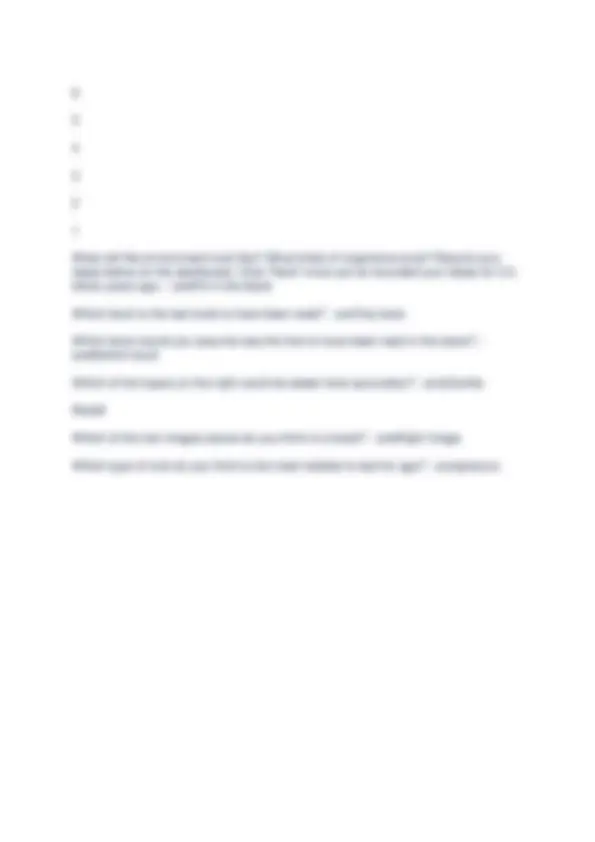



Study with the several resources on Docsity

Earn points by helping other students or get them with a premium plan


Prepare for your exams
Study with the several resources on Docsity

Earn points to download
Earn points by helping other students or get them with a premium plan
Community
Ask the community for help and clear up your study doubts
Discover the best universities in your country according to Docsity users
Free resources
Download our free guides on studying techniques, anxiety management strategies, and thesis advice from Docsity tutors
This educational resource explores the process of fossil formation and dating. It presents a series of questions and exercises designed to guide learners through the identification, classification, and interpretation of fossils. The resource utilizes visual aids and interactive elements to enhance understanding of key concepts such as trace fossils, body fossils, and the relative dating of rock layers.
Typology: Exams
1 / 3

This page cannot be seen from the preview
Don't miss anything!


Although they are very similar, what differences do you see between them? Please select all choices that apply. - ansThey have different color patterns. The teeth are a different shape Some pieces are present in one and missing in the other. Based on what we've studied thus far, what kind of fossil do you think it might be? - ansTrace Fossil / Indirect Evidence Before we get into applying what we know, what do you believe are other logical scenarios for this book sequence? Select all that you think apply - ansThe stack was originally standing upright and later moved to this position. Two stacks were combined. Body Fossil: Direct Evidence - ansSkull image, and the Fish image Description 1 - ansAn Ammonite(a shellfish with a spiral-shaped shell) dies and falls to the bottom of the sea where it is covered by sediments. Description 2 - ansMore sediment covers and squeezes the shell. It may undergo mineralization or other processes that make it more stone like. Description 3 - ansAfter millions of years, movement of the Earth's crust may push the layer of sedimentary rock containing the fossil upwards towards the surface. Description 4 - ansWeathering and erosion eventually wear away some of the rock, exposing the fossil. Fossils are often found in quarries or other dig sites. How can we best determine how this fossil was created? - ansuse all of the above methods How could you describe this fossil? - ansan impression of the organism, but not the organism itself How could you describe this fossil? - anssomething an organism did How could you describe this fossil? - anssomething produced biologically by the organism, but not the organism itself How could you describe this fossil? - ansthe remains of a body are embedded in the rock
How do you think scientists can determine the age of these rocks? - ansThey will use chemistry. image 1 - ansshellfish on top of the soil image 2 - ansthe shell buried three lays down image 3 - ansfull box of soil with the shell in the layers image 4 - ansshell sticking out of the soil Now consider 65 million years ago. Record your ideas on the dashboard. - ansFill in the blank Now consider 560 million years ago. Record your ideas on the dashboard. Click "Next" when you are done. - ansFill in the blank Select the image below that appears to contain a fossil - ansFirst image Select the image below that appears to contain a fossil. - anssecond image Select the image below that appears to contain a fossil. - anssecond image Select the image below that appears to contain a fossil. - ansSecond image The dinosaur fossil (3) is: - ans< 348 mya The gneiss (6) is: - ans> 348 mya & ≤1 bya The jellyfish layer (5) is: - ans> 348 mya & ≤1 bya The limestone (2) is: - ans< 348 mya The sandstone (1) is: - ans< 348 mya The stromatolite (8) is: - ans>1 bya Trace Fossil: indirect Evidence - ansStarfish image, Paw prints image, Fecal matter image, tree root image Using the previous book on the end table example, let's take a moment to sequence the events here. In the boxes, sequence the events using numbers 1 through 8. 1 being the oldest layer, 8 being the youngest. Each number may only be used once. Then, click next. - ans 7